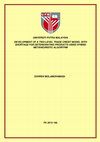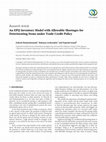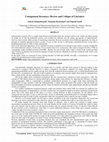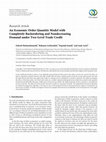Papers by Zohreh Molamohamadi

In the classical inventory systems, it was implicitly assumed that the buyer pays to the vendor a... more In the classical inventory systems, it was implicitly assumed that the buyer pays to the vendor at the time of receiving the items. In real world, however, the vendor usually allows the buyer to defer payment. Among different types of delay in payment, trade credit has attracted many researches’ attention and still has great potential for further studies. For example, most of the previous studies have considered constant demand, while the demand in real market is dependent to several factors such as price, time, inventory, etc. Besides, for simplicity in modelling and solving, the researchers often ignore shortage and deterioration rate which are parts and parcels of today’s business. Two-level trade credit is another potential area for exploration. It is referred to the case that not only the vendor offers credit period to the buyer, but also the buyer allows its customers to delay payment. Furthermore, most of the previous studies have considered Economic Order Quantity (EOQ) mode...
This paper considers a two-level supply chain consisting of a manufacturer and two buyers. The ma... more This paper considers a two-level supply chain consisting of a manufacturer and two buyers. The manufacturer produces one type of products at a finite rate and replenishes them to the buyers. Each buyer's demand is sensitive to his selling price and the backorder is allowed at the buyers. Moreover, it is assumed that the buyers delay paying for goods to the manufacturer and two types of delay in payment are considered; delay paying for the purchased items till they are used or sold to the end customers, and delay paying till the next replenishment order. The main aim of this research is formulating the manufacturer and the buyers' problems in terms of integer-ratio policy and discounted cash flow under these two types of delay in payment.
International Journal of Mathematics in Operational Research, 2020
AIP Conference Proceedings, 2009
Consignment Inventory (CI) is a kind of inventory which is in the possession of the customer, but... more Consignment Inventory (CI) is a kind of inventory which is in the possession of the customer, but is still owned by the supplier. This creates a condition of shared risk whereby the supplier risks the capital investment associated with the inventory while the customer risks ...

Production & Manufacturing Research, 2013
This paper considers a centralized supply chain with consignment inventory (CI) system, where a v... more This paper considers a centralized supply chain with consignment inventory (CI) system, where a vendor keeps a finished product and supplies it at the same price to multiple buyers. CI is a process where the buyer pays with delay for the goods supplied by the vendor. Considering the time value of money, this study compares two types of delay in payment in CI, which have been rarely considered (real use and order to order). Furthermore, two different metaheuristic algorithms, genetic algorithm (GA) and a hybrid algorithm, containing GA and particle swarm optimization algorithm, are used to maximize the supply chain net profit and calculate the proper values. Finally, a sensitivity analysis is performed to examine the effects of each parameter on the total net profit. Moreover, by applying a paired t-test, a comparison is made between two types of CI system and also between GA and the hybrid algorithm.

Journal of Advanced Management Science, 2013
Supplier selection is a process by which the firms identify, evaluate, and select the suppliers o... more Supplier selection is a process by which the firms identify, evaluate, and select the suppliers of their required raw materials. Although this process deploys an overwhelming amount of any firm's financial resources, it would give substantial advantages if suppliers with high value are selected. Moreover, with paying more attention to the exhaustible natural resources and industrial pollution, sustainable supply chain management and sustainable supplier selection have significantly attracted the academic and corporate attention in recent years. Besides conventional criteria such as price and quality, sustainability cares about environmental and ecological respects of industrial activities. Reviewing the literature and considering the previous proposed frameworks for sustainable supply chain, this paper firstly aims at presenting a new structure which considers all of the influential relations between the members of the supply chain. Secondly, based on the new framework, the essential supplier selection measures and criteria are discussed. As the result, the offered scheme can be used by the manufacturers to select the most appropriate suppliers who contribute to the movement of the supply chain toward sustainability.

International Journal of Materials, Mechanics and Manufacturing, 2013
Due to the increasing expenses of energy, industrial contamination, deficiencies of strategic raw... more Due to the increasing expenses of energy, industrial contamination, deficiencies of strategic raw materials and natural resources, and ecological disasters, sustainability has become one of the most prominent areas in the recent researches. Having a profound effect on all of the organizational aspects of human life, sustainability related issues maintain a strong mutual relationship with manufacturing, as the main aspect of the modern lifestyle. Having considered the previous suggested frameworks for sustainable manufacturing, this paper proposes a new structure where not only do the three major pillars of sustainability have interlink connections, but also two more enablers are introduced to be added to the previous ones to develop the existing frameworks. Moreover, a holistic review of sustainability, its definitions, background and current issues are represented here to offer appropriate options to the manufacturing systems for moving faster and safer toward a sustainable future.

PsycEXTRA Dataset
This dissertation was written as part of the MSc in Sustainable Development at the International ... more This dissertation was written as part of the MSc in Sustainable Development at the International Hellenic University. The concept of sustainability is now a key factor, for business and society and for the environment as well. The question, which enters now, is how the concept of sustainability should be connected or implemented in human resource management. The existing literature shows the need for the emergence of a new concept: (sustainable human resource management). The discussion on the relationship, between sustainability and human resource management, admit more and more attention to be paid by academics and other specialists and professionals. It is commonly know that in any theoretical study, all factors should be taken into consideration, so as, a clear view, about the mentioned study, to be finally extracted. In this paper particular attention is paid, to draw the definitions and the evolution of the concepts of SD, CSR and HRM. The objective of this paper is to present the current theoretical approaches in the literature on: a) the classification and the description of the theoretical views on the concepts of CSR, SD and HRM b) put these concepts to the wider theoretical scope, so they became endeavor for alignment and consistency of them and c) finally to present the four models of Sustainable Human Resource Management that currently dominate the literature.

Discrete Dynamics in Nature and Society, 2014
This paper attempts to obtain the replenishment policy of a manufacturer under EPQ inventory mode... more This paper attempts to obtain the replenishment policy of a manufacturer under EPQ inventory model with backorder. It is assumed here that the manufacturer delays paying for the received goods from the supplier and the items start deteriorating as soon as they are being produced. Based on these assumptions, the manufacturer’s inventory model is formulated, and cuckoo search algorithm is applied then to find the replenishment time, order quantity, and selling price with the objective of maximizing the manufacturer’s total net profit. Besides, the traditional inventory system is shown as a special case of the proposed model in this paper, and numerical examples are given to demonstrate better performance of trade credit. These examples are also used to compare the results of cuckoo search algorithm with genetic algorithm and investigate the effects of the model parameters on its variables and net profit.

Consignment inventory (CI) is a supply chain business partnership where the customer orders to th... more Consignment inventory (CI) is a supply chain business partnership where the customer orders to the vendor, but delays paying for goods. In CI, like the traditional systems, each member has authority over the timing and quantity of replenishments; however, these systems differ in time of transferring ownership. Previous researches showed different approaches for delay in payment in customer managed inventory systems: (1) pay as sold, (2) pay as sold during a predefined period, (3) pay after a predefined period and (4) order to order consignment. Each of the mentioned approaches can be considered as delay in payments in CI, though in most studies, it mainly included the first aforementioned category. In this type, CI was mostly taken to be synonymous with vendor managed inventory (VMI) or consignment vendor managed inventory (C&VMI). Besides, the area of trade credit, which is based on the second and third types of delay in payment, has received the attention of many researchers, alth...
Discrete Dynamics in Nature and Society, 2014
In the classical inventory models, it was assumed that the buyer pays for the purchased items as ... more In the classical inventory models, it was assumed that the buyer pays for the purchased items as they are received from the seller. In practice, however, the seller allows the buyer to settle the account with a delay period. Such a contract has attracted the attention of many researchers and practitioners in recent years. Thus, this paper addresses the researches with delay in payment and presents pertinent information about developments and extensions of such models to provide an up-to-date review of the studies conducted since 1973 and assist in developing the future researches.

In today’s business transactions, human resources have the major contribution to achieving organi... more In today’s business transactions, human resources have the major contribution to achieving organizational success. Merging sustainability into organizational goals and outcomes makes them the driving force of the organization. This paper views the relationship between human resource management and sustainable development from two different perspectives; In the first approach, human resources are considered as a means of gaining sustainable development, while in the second approach the employees’ knowledge, experience, abilities and skills, as the organizations’ invaluable resources, are valued and well preserved. Based on the first viewpoint, human resources must be trained and managed to apply energy and resources sparingly to provide the best environmental, social, and economic condition. In the latter, however, the best possible environmental, social, and economic conditions are needed to take advantage from the employees’ knowledge and skills.

In the classical inventory systems, the retailer had to settle the accounts of the purchased item... more In the classical inventory systems, the retailer had to settle the accounts of the purchased items at the time they were received. But in practice, the supplier applies some strategic tools, such as trade credit contract, to enhance his sales channel and offers delay period to his customers to settle the account. Any member of the supply chain may offer full or partial trade credit contract to his downstream level. Full trade credit is the case that the latter is allowed to defer the whole payment to the end of the credit period. In partial trade credit, however, the downstream supply chain member must pay for a proportion of the purchased goods at first and can delay paying for the rest until the end of the credit period. This paper considers a two-level trade credit, where the supplier offers order-quantity-dependent partial trade credit to a retailer, who suggests full trade credit to his customers. An economic order quantity (EOQ) inventory model of a deteriorating item is formu...
Consignment Inventory (CI) is a kind of inventory which is in the possession of the customer, but... more Consignment Inventory (CI) is a kind of inventory which is in the possession of the customer, but is still owned by the supplier. This creates a condition of shared risk whereby the supplier risks the capital investment associated with the inventory while the customer risks ...

Applied Mechanics and Materials, 2014
It has been a while since supply chain management (SCM) has shifted its focus from production eff... more It has been a while since supply chain management (SCM) has shifted its focus from production efficiency to sustainability related issues. Implementing this strategic shift demands all supply chain members, all processes, and generally all of the elements to be involved in helping the chain move faster and further toward sustainability. This has necessitated the strong relationship between supply chain and the three sustainability pillars: environment, economy, and society. Having considered this essentiality, this paper, describes the supply chain, sustainable development and discusses their existing definitions in the literature. The relationship between supply chain and sustainability is then discussed and a framework for sustainable supply chain is proposed based on the previous suggested structures for supply chain and sustainable development.
International Journal of Innovation, Management and Technology, 2014

Advances in Decision Sciences, 2014
In the traditional inventory system, it was implicitly assumed that the buyer pays to the seller ... more In the traditional inventory system, it was implicitly assumed that the buyer pays to the seller as soon as he receives the items. In today's competitive industry, however, the seller usually offers the buyer a delay period to settle the account of the goods. Not only the seller but also the buyer may apply trade credit as a strategic tool to stimulate his customers' demands. This paper investigates the effects of the latter policy, two-level trade credit, on a retailer's optimal ordering decisions within the economic order quantity framework and allowable shortages. Unlike most of the previous studies, the demand function of the customers is considered to increase with time. The objective of the retailer's inventory model is to maximize the profit. The replenishment decisions optimally are obtained using genetic algorithm. Two special cases of the proposed model are discussed and the impacts of parameters on the decision variables are finally investigated. Numerical examples demonstrate the profitability of the developed two-level supply chain with backorder.

Applied Mechanics and Materials, 2014
ABSTRACT It has been a while since supply chain management (SCM) has shifted its focus from produ... more ABSTRACT It has been a while since supply chain management (SCM) has shifted its focus from production efficiency to sustainability related issues. Implementing this strategic shift demands all supply chain members, all processes, and generally all of the elements to be involved in helping the chain move faster and further toward sustainability. This has necessitated the strong relationship between supply chain and the three sustainability pillars: environment, economy, and society. Having considered this essentiality, this paper, describes the supply chain, sustainable development and discusses their existing definitions in the literature. The relationship between supply chain and sustainability is then discussed and a framework for sustainable supply chain is proposed based on the previous suggested structures for supply chain and sustainable development.











Uploads
Papers by Zohreh Molamohamadi